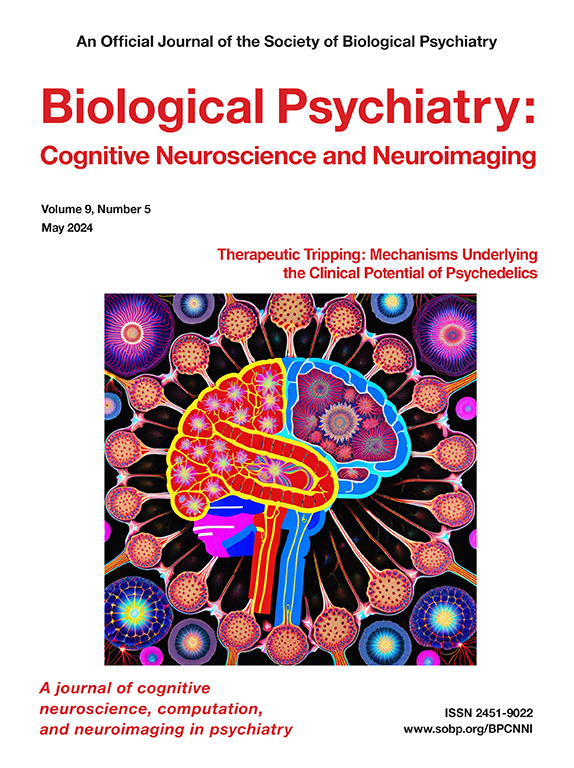Effects of Electroconvulsive Therapy on Brain Structure: A Neuroradiological Investigation Into White Matter Hyperintensities, Atrophy, and Microbleeds
IF 4.8
2区 医学
Q1 NEUROSCIENCES
Biological Psychiatry-Cognitive Neuroscience and Neuroimaging
Pub Date : 2025-08-01
DOI:10.1016/j.bpsc.2024.12.004
引用次数: 0
Abstract
Background
Electroconvulsive therapy (ECT) is a well-established treatment for severe depression, but it remains stigmatized due to public perceptions linking it with brain injury. Despite extensive research, the neurobiological mechanisms underlying ECT have not been fully elucidated. Recent findings suggest that ECT may work through disrupting depression circuitry. However, whether ECT is associated with neuroradiological correlates of brain injury, including white matter changes, atrophy, and microbleeds, remains largely unexplored.
Methods
We performed magnetic resonance imaging (MRI) scans on 36 ECT patients (19 female), 19 healthy control participants (11 female), and 18 patients with atrial fibrillation (1 female) who were treated with electrical cardioversion while receiving an equivalent anesthetic as the ECT group. Scans were conducted at 4 time points: at baseline, after the first ECT treatment, after the ECT series, and at 6-month follow-up. We evaluated white matter changes using the Fazekas and the age-related white matter changes scales, atrophy using the global cortical atrophy and medial temporal lobe atrophy scales, and cerebral microbleeds using the Microbleed Anatomical Rating Scale. Data were analyzed using nonparametric statistical methods.
Results
Patients did not show any changes in radiological scores after ECT (all ps > .1), except for a decrease in microbleeds (p = .05).
Conclusions
Utilizing state-of-the-art MRI techniques, we found no significant evidence that ECT induces white matter changes, atrophy, or microbleeds. Thus, although ECT may work through disrupting depression circuitry, the treatment is not associated with neuroradiological signs of brain injury.
电休克治疗对脑结构的影响——白质高信号、萎缩和微出血的神经放射学研究。
背景:电痉挛疗法(ECT)是一种公认的治疗重度抑郁症的方法,但由于公众认为它与脑损伤有关,它仍然被污名化。尽管进行了广泛的研究,ECT的神经生物学机制尚未完全阐明。最近的研究结果表明,电痉挛疗法可能是通过破坏抑郁回路而起作用的。然而,ECT是否与脑损伤的神经放射学相关,包括白质改变、萎缩和微出血,在很大程度上仍未被探索。方法:我们对36名ECT患者(19名女性)、19名健康对照(11名女性)和18名房颤患者(1名女性)进行了MRI扫描,这些患者在接受电复律治疗的同时接受了与ECT组相同的麻醉。扫描在四个时间点进行:基线时,第一次ECT治疗后,ECT系列治疗后,以及六个月的随访。我们使用Fazekas和年龄相关白质变化量表评估白质变化,使用全球皮质萎缩和内侧颞叶萎缩量表评估脑萎缩,使用微出血解剖评定量表评估脑微出血。数据分析采用非参数统计方法。结果:除微出血减少外,ECT术后患者放射学评分无明显变化(p < 0.05)。结论:利用最先进的MRI技术,我们没有发现电痉挛引起白质改变、萎缩或微出血的明显证据。因此,尽管电痉挛疗法可能通过破坏抑郁回路而起作用,但这种疗法与脑损伤的神经放射学症状无关。
本文章由计算机程序翻译,如有差异,请以英文原文为准。
求助全文
约1分钟内获得全文
求助全文
来源期刊

Biological Psychiatry-Cognitive Neuroscience and Neuroimaging
Neuroscience-Biological Psychiatry
CiteScore
10.40
自引率
1.70%
发文量
247
审稿时长
30 days
期刊介绍:
Biological Psychiatry: Cognitive Neuroscience and Neuroimaging is an official journal of the Society for Biological Psychiatry, whose purpose is to promote excellence in scientific research and education in fields that investigate the nature, causes, mechanisms, and treatments of disorders of thought, emotion, or behavior. In accord with this mission, this peer-reviewed, rapid-publication, international journal focuses on studies using the tools and constructs of cognitive neuroscience, including the full range of non-invasive neuroimaging and human extra- and intracranial physiological recording methodologies. It publishes both basic and clinical studies, including those that incorporate genetic data, pharmacological challenges, and computational modeling approaches. The journal publishes novel results of original research which represent an important new lead or significant impact on the field. Reviews and commentaries that focus on topics of current research and interest are also encouraged.
 求助内容:
求助内容: 应助结果提醒方式:
应助结果提醒方式:


